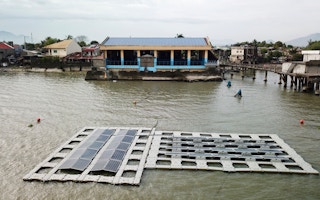Low investor turnout for the Philippine national government’s renewable energy auction programme might have raised some eyebrows, with even the energy secretary himself cautioning that delays in crucial transmission projects have resulted in “dwindling” private sector interest in the initiative, but some energy experts are advising that the industry take a glass-half-full view of the latest developments.
To continue reading, subscribe to Eco‑Business.
There's something for everyone. We offer a range of subscription plans.
- Access our stories and receive our Insights Weekly newsletter with the free EB Member plan.
- Unlock unlimited access to our content and archive with EB Circle.
- Publish your content with EB Premium.
The government’s failure to reach its goal for renewable energy capacities in the latest round of competitive bidding in July need not be taken negatively, advised an energy expert.
Marlon Apañada, Southeast Asia engagement lead, energy and climate, for global research nonprofit World Resources Institute, told Eco-Business that seen in perspective, the auction has still been helpful towards increasing the share of renewables in the country’s energy mix.
Apañada said even if an original goal set by the government was not met, the process still added at least 3,000 megawatts (MW) of new renewable energy, which is more than than what was installed in the past seven years.
“It should still be seen as a success,” he said.
The Green Energy Auction Programme was kickstarted to make the procurement of renewable energy supply in the Philippines a competitive process. It is one of the policies put in place to help the country achieve the goals set under the Renewable Energy Act of 2008, which aims to reach a 35 per cent renewable energy target by 2030.
Last year, the department of energy declared a successful first round of the programme after awarding around 2,000 MW in renewable energy capacities to 19 winning bidders. It was able to generate about 1,960 MW to be delivered from 2023 to 2025.
On 3 July this year, the energy department auctioned off 11,600 MW of green energy capacities that must be available in the next three years, but the private sector only committed to providing 3,440.76 MW of new energy to be installed over three years until 2025.
In explaining his stance, Apañada said that the committed capacities are still at almost twice of what has been generated.
A bulk of the new clean energy projects from the auction pledged are for solar, including ground-mounted, rooftop and floating facilities pledged for 2023 to 2026. A third of the capacity was awarded to bidders of onshore wind power plants, to be developed for 2025 and 2026.
“We started with a high ambition of 11,600 MW, so that we are able to leave some ‘room for error’,” added Apañada. “Grid improvements should make the next round of auctions more successful.”
Delays in crucial transmission projects under the National Grid Corp. of the Philippines (NGCP) have been blamed by the government for the low turnout at last month’s green energy auction.
The NGCP, which won the competitive bidding in 2009 to manage and operate the country’s transmission grid, has been in hot water since transmission issues triggered widespread power interruptions experienced by households in the Luzon island group in May.
In his latest comments, energy secretary Raphael Lotilla told local media that that the level of interest of bidders “dwindled” as the auction date drew close because of uncertainties.
“The availability of transmission lines was also a concern raised [by the private sector] because the system impact studies are delayed,” he reportedly said, referring to the studies conducted by NGCP assessing the capability of transmission lines to absorb new capacities.
The Philippines has pledged to increase the share of renewables in the country’s energy mix from the current 21 per cent to 35 per cent by 2030 and 50 per cent by 2040.
Want more Philippines ESG and sustainability news and views? Subscribe to our Eco-Business Philippines newsletter here.










